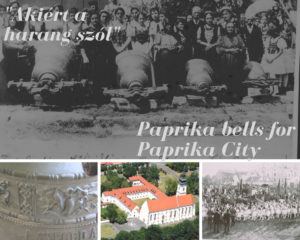Churches have always been centres of communities. When bells in the first world war were commonly taken and melted down for military purposes, the church-going community immediately started collecting money for the new bells. It took about five years for Szeged-Alsóváros people to collect money for the new bells for their church.
In 1921 the bells (one lead bell and three smaller ones) were constructed, cast, tuned and were ready to be carried to Szeged. The lead bell weighed 710 kg, its diameter was 112 cm and its most outstanding feature was the beautiful paprika plant motifs that adorned the bell. It is very uncommon to choose plants to adorn a bell, but because it was paprika growers and producers that collected the money for the bells the church consented. The lead bell is now referred to as Paprika Bell and it is adorned not only with paprika designs but with all the names of the proud paprika people that donated the money for the new bells. It is a beautiful example of the pride that paprika people felt about what they were doing, what they were making a living from.
The community chose as patron saint of the bell Saint Piroska in honour of the Hungarian princess. Her figure also features on the lead bell. Piroska at the time was the most common female name and I can’t help but feel that this had also to do with paprika. (A note for non-Hungarian speakers: Piros means red, piroska means Little red. The connection between red paprika, the many Piroskas and Saint Piroska seems obvious.)
The new bells were mounted and consecrated in 1921, only a year after the Treaty of Trianon, which proved so tragic for Hungary. In the 1920 treaty Hungary lost two-third of its territory and its people. All the work that went into the realization of the bell project – planning, making the decision, collecting the money, choosing the design and realizing the entire project – had its absolutely great reward for the local people. Crowds were gathering and accompanying the bells from the railway station to the church and watched in awe the fitting of the bells to their final places. The consecration of the church bells and the ringing of the new bells must have been an unforgettable moment for the people of Szeged-Alsóváros and a rare expression of national and community pride.
The Paprika Bell was almost melted down for military purposes in the second world war, but luckily escaped this fate. However, it could not stand time: in 2005 it cracked and had it not been for Szeged people, it would have been remelted and recast. The money to save and replace the Paprika Bell and have a new one made came from various people and institutes including Paprikamolnár. The new bell is named after the ethnographer and paprika researcher Sándor Bálint and it is happily chiming for ceremonies. The Paprika Bell is now repaired and retired. You can see it full beauty in the Franciscan visitor centre.
Tetszett a cikk? Ha szeretne még paprikás és fűszeres témában, heti rendszerességgel cikket olvasni, hírt kapni az ÚJ paprika elkészültéről, iratkozzon fel hírlevelünkre. Subscribe to our Blog and enjoy our Paprika Poster.







